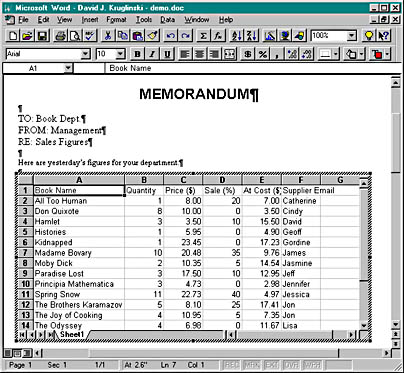Embedding vs. In-Place Activation (Visual Editing)
Visual Editing is Microsoft's name for in-place activation. A component that supports in-place activation also supports embedding. Both in-place activation and embedding store their data in a container's document, and the container can activate both. An in-place-capable component can run inside the container application's main window, taking over the container's menu and toolbar, and it can run in its own top-level window if necessary. An embedded component can run only in its own window, and that window has a special menu that does not include file commands. Figure 28-1 shows a Microsoft Excel spreadsheet in-place activated inside a Microsoft Word document. Notice the Excel menus and toolbars.
Some container applications support only embedded components; others support both in-place and embedded components. Usually, an in-place container program allows the user to activate in-place components either in place or in their own windows. You should be getting the idea that embedding is a subset of in-place activation. This is true not only at the user level but also at the OLE implementation level. Embedding relies on two key interfaces, IOleObject and IOleClientSite, which are used for in-place activation as well.

Figure 28-1. An Excel spreadsheet activated inside a Word document.
EAN: 2147483647
Pages: 332